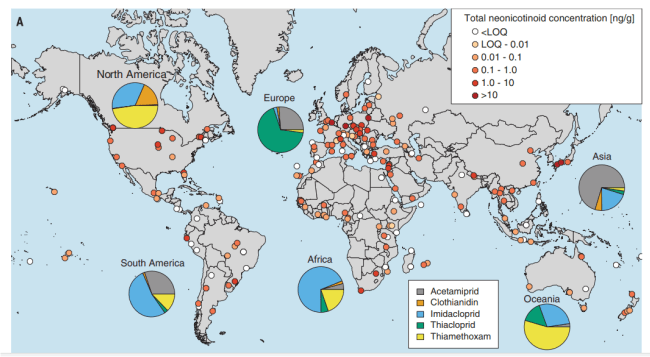To ask if there are pesticides in honey is quite legitimate. If those toxic chemicals are in flowers’ nectar aren’t they in honey, too? Are they dangerous to us? will see…
Agriculture needs toxic chemicals to fight against weeds, insects, bacteria, rodents and so many others. To resist those poisoning substances, the plants have been GMO-ed. Everything has changed. And this change threatens the quality of the other byproducts, like honey.
The commonly used insecticides, known as neonicotinoids, are absorbed by plants and spread throughout their tissues. When pollinators collect and consume contaminated pollen and nectar 2 things happen:
1. what they produce (honey, pollen etc) will contain those substances;
2. these toxic chemicals will affect the bees’ organisms. Studies have shown that they can suffer from learning and memory problems that hamstring their ability to gather food and sometimes threaten the health of the whole hive. Since the problem we are confronting, called colony collapse disorder, aka CCD. (see What causes CCD? Do pesticides kill bees? Or radiations? Pathogens? Aliens?)
• The study published in Science 358, no 6359, 109-111, October 2017, A worldwide survey of neonicotinoids in honey, by E. A. D. Mitchell et al. from Switzerland, offers an answer to the question and tells us if pesticides are a real threat for us all.
The researchers asked their friends, relatives, and colleagues around the world to provide locally sourced honey. They send 198 samples from all around the world. All of them were tested for the presence of 5 neonicotinoids: acetamiprid, clothianidin, imidacloprid, thiacloprid, and thiamethoxam. The results showed there was at least 1 out of the 5 chemicals.
75% of all samples – contained 1 neonicotinoid
45% of all samples – contained 2 or 3 neonicotinoids
10% of all samples – contained 4 or 5 neonicotinoids
The most frequent neonicotinoids were found in honey samples from North America (where 86% had one or more neonicotinoid), and least often in South America, where they occurred in 57% of samples.


Are the pesticides present in honey dangerous for humans?
Not according to regulations.
Maximum residue levels (MRLs) authorized in food and feed products in the European Union (EU MRLs) are:
· 50 ng/g for acetamiprid, imidacloprid, and thiacloprid
· 10 ng/g for clothianidin and thiamethoxam.
And they were not reached for any tested neonicotinoid.
The sum of percentages of EU MRLs for the five neonicotinoids reached 3.6%, on average, for all positive samples, exceeded 10% in eight samples, and surpassed 100% (!!) in two European samples.
In conclusion, although at a global scale, 75% of all samples tested positive for at least one neonicotinoid the concentrations were below the admissible limits for human consumption according to current EU and U.S. regulations (i.e., maximum residue limits). According to them, consumption of honey is therefore not thought to harm human health.
But if you are asking, no, the fact that they don’t reach a dangerous limit set by current regulations (which can change any time, as they have always done), DOES NOT MAKE THEM ORGANIC.
♣ read more on Organic honey vs regular honey
Are regulations good enough for our health?
First of all, these regulations were made taking in consideration a healthy individual. And let’s be serious, the majority of us is not healthy. We all have different backgrounds and our bodies react differently. That accepted limit of pesticides may be very harmful for a person with a chronic disease, or in an acute state.
Secondly, the effects on humans have not been tested on a long distance. Chemicals like pesticides, additives, antibiotics, they all gather in our body with every processed meal that we have, or with every spoon of honey that we take.
The accepted limit refers to humans, in this moment, for this specific quantity. Yet, nobody knows what will happen in 20 or 30 years, after all these chemicals have gathered and got stuck in our bodies. (Our children will surely write about it!)
Thirdly, regulations change in time. It was the case with the maximum limit of a toxic compound that could also be found in honey: tutin. The article A new dispute on manuka honey market: Is it toxic or not? shows you how these figure change after incidents occur.
Till March 2015, there was a limit of accepted tutin in honey of 2 mg/kg, and of 0.1 mg/kg for comb. Starting from 12 March 2015 there is only one regulation: 0.7 mg/kg of accepted tutin in honey or comb.
There’s a long distance from 2 to 0.7….
The above mentioned study says: our “recent evidence for impacts of neonicotinoids on vertebrates (. D. Gibbons et all, 2015, N. Hoshi et al. 2013), including humans (K. H. Harada et al. 2016, L. Wang et al 2015, 4. A. M. Cimino et al. 2017), and especially evidence for up-regulation of nicotinic a4b2 AChRs receptors in the mammal brain during chronic exposure and for higher affinity of metabolites versus the parent neonicotinoid (imidacloprid) (M. Tomizawa et al. 2000), could lead to reevaluating maximum residue limits.”
Search for Tolerances for Pesticide Ingredients in the Code of Federal Regulations
Pesticides affect the health of honey bees
Although the impact of the measured concentrations of neonicotinoids in honey on vertebrates, including humans, is considered negligible, a significant detrimental effect on bees is likely for a substantial proportion of the analyzed samples, as adult bees rely on honey for food, including during periods of overwintering or seasons without blossoming flowers.
The effects of neonicotinoids (though in sub-lethal doses) on bees and other insects include: growth disorders, reduced efficiency of the immune system, neurological and cognitive disorders, respiratory and reproductive function and jeopardize queen survival, foraging efficiency, and homing capacity. All at concentrations as low as 0.10 ng/g.
When combine to other pesticides, neonicotinoids may increase the harm to pollinators.
Neonicotinoids + poor food = 50 % decrease in bees’ health
Even more, when neonicotinoids are combined with poor food, the damage is even bigger.
The American Bee Journal has recently published the results of a study published in Dec. 20 2017, in Proceedings of the Royal Society B, by Simone Tosi, James Nieh and their colleagues, who showed how honey bees fared with exposure to neonicotinoids along with limited nutrient sources, scenarios that are commonly found in agricultural areas.
The studied neonicotinoid were clothianidin and thiamethoxam, which are the most common pesticides used worldwide in vegetable, fruit and grain crops. Chemicals once applied to crops, remain in the environment and can be found in nectar, pollen, water and soil.
The results showed that bee deaths increased by up to 50 percent more than they expected compared with the individual effects of pesticides and poor nutrition.
The explanation is that bees use sugar to fuel their flights and work inside the nest. Pesticides decrease their hemolymph (“bee blood”) sugar levels and therefore decreased their energy stores.
Should we not eat honey anymore?
No, that’s not the correct question? We should be asking ourselves what kind of honey should we eat, that is as free of pesticides as possible.
First of all raw honey doesn’t mean pesticide free. It only means the honey was not processed. You’ll find other details here Organic honey vs regular honey and here What is organic honey?
There are still farmers who grow their crops without pesticides. There are farmers who tell beekeepers when they are going to spray their crops, so they can move the hives. Ask your local about it.
And, to be absolutely sure, try honey from the forests, from pine or from wildflowers. Even if the fields might get sprayed with the wind, or the bees find the crops found in proximity more appealing, the quantity of pesticides is not as much.
Or, why not, top quality honey like sidr honey, tualang honey or manuka honey.
And when buying search for specific labels like ‘True Source Verified’ (in the US), though this doesn’t say much. But other countries do have standards. Read more on What is organic honey?.
============
============
References:
americanbeejournal.com/
A worldwide survey of neonicotinoids in honey by bE. A. D. Mitchell et al. from Switzerland, published in Science 358, no 6359, 109-111, 2017





